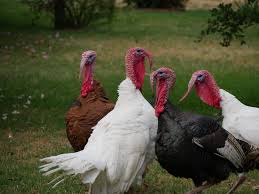November, the month of the turkey, has arrived. We thought you might want to impress your friends and family with some facts about this much respected bird, a true native of America.

Ben Franklin thought the turkey would be a better national symbol than the bald eagle.
The average person in the United States will eat 15 pounds of turkey this year.
The loose red skin attached to the underside of a turkey’s beak is called a wattle. When the male turkey is excited, especially during mating season, the wattle turns scarlet. The fleshy flap of skin that hangs over the gobbler’s beak is called a snood and also turns bright red when the bird is excited.
The wild turkey is one of the more difficult birds to hunt. It won’t be flushed out of the brush with a dog. Instead, hunters must try to attract it with different calls. Even with two turkey hunting seasons a year, only one in six hunters will get a wild turkey.
By the 1930’s, almost all of the wild turkeys in the U.S. had been hunted. Today, thanks to conservation programs, there are plenty of wild turkeys.
A male turkey is called a tom, a female is a hen, and a youngster is a poult.
The domestic tom can weigh up to 50 pounds, the domestic hen up to 16 pounds. The wild tom can weigh up to 20 pounds, the wild hen up to 12 pounds.
The wild turkey can fly! The domestic turkey is not a very good flyer, though the bird will perch in a tree to stay safe from predators.
The average life span of a domestic turkey, from birth to freezer, is 26 weeks. During this period of time, it will eat about 75 pounds of turkey feed. The average life span of a wild turkey is three or four years. It generally feeds on seeds, nuts, insects, and berries.
The wobbly little thing on the turkey’s chest is the turkey’s beard and is made up of keratin bristles. Keratin is the same substance that forms horns on other animals.
Only male turkeys, or toms, can gobble, and they mostly do it in the spring and fall. It is a mating call and attracts the hens. Wild turkeys gobble at loud sounds and when they settle in for the night.
Turkeys perched on trees and refusing to descend indicates snow.
Turkey has become the traditional Thanksgiving fare because at one time it was a rare treat. During the 1830’s, an 8 to 10 pound bird cost a day’s wages. Even though turkeys are affordable today, they still remain a celebratory symbol of bounty. In fact, astronauts Neil Armstrong and Edwin Aldrin ate roast turkey in foil packets for their first meal on the Moon.
How to Roast a Turkey

Place a thawed or fresh turkey, breast up, on a flat rack in a shallow pan, 2 to 2 ½ inches deep.
Brush or rub the skin with oil to prevent drying of the skin and to enhance the golden color.
Place into a preheated 325 degree F oven.
When the skin is a light golden color and the turkey is about two-thirds done, shield the breast loosely with a tent of lightweight foil to prevent overcooking of the breast.
Use an instant-read thermometer to test for doneness. The turkey is cooked when it reaches 165 degree F. Check the temperature:
– deep in the thigh (juices should be clear, not pink when the thigh muscle is pierced deeply),
– in the thickest part of the breast, just above the rib bones,
– in the center of the stuffing (if the turkey is stuffed).
Roasting Times
8 to 12 pound turkey 2 ½ to 3 hours (unstuffed) 3 to 3 ½ hours (stuffed)
12 to 14 pound turkey 3 to 3 ½ hours (unstuffed) 3 ½ to 4 hours (stuffed)
14 to 18 pound turkey 3 ½ to 4 ½ hours (unstuffed) 4 to 4 ½ hours (stuffed)
18 to 20 pound turkey 4 ½ hours (unstuffed) 4 ¾ hours (stuffed)
20 to 24 pound turkey 4 ½ to 5 hours (unstuffed) 4 ¾ to 5 ½ hours (stuffed)
Be sure to order your FRESH turkey, now!
Pressler’s Meats, Inc.
2553 Pressler Road
Akron, Ohio 44312
330/644-5636
Tues. thru
Fri. 9:00AM-5:00PM, Sat 8:00AM-5:00PM
Closed Sunday and Monday
Meat Market & Retail Store–
Custom Butchering